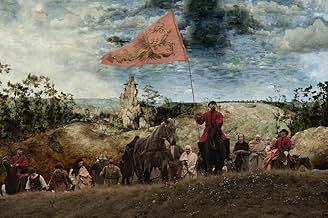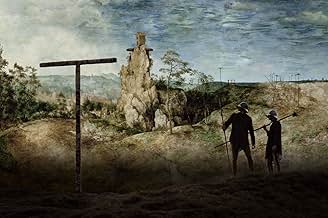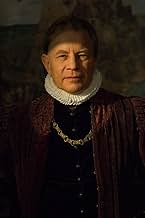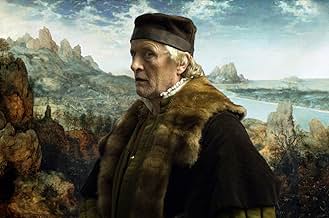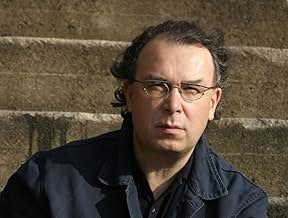VALUTAZIONE IMDb
6,8/10
4556
LA TUA VALUTAZIONE
Aggiungi una trama nella tua linguaThis movie focuses on a dozen of the five hundred characters depicted in Bruegel's painting. The theme of Christ's suffering is set against religious persecution in Flanders in 1564.This movie focuses on a dozen of the five hundred characters depicted in Bruegel's painting. The theme of Christ's suffering is set against religious persecution in Flanders in 1564.This movie focuses on a dozen of the five hundred characters depicted in Bruegel's painting. The theme of Christ's suffering is set against religious persecution in Flanders in 1564.
- Regia
- Sceneggiatura
- Star
- Premi
- 10 vittorie e 7 candidature totali
Recensioni in evidenza
The Mill and the Cross (2011)
Maybe I anticipated this for too long, hearing about its production, and teaching in an Art History department myself. The result is both astonishing and boring as heck. I know, there is a kind of absorption that happens through silence and slow appreciation. And there is even the astonishment of looking without really thinking, or feeling, for the narrative or the characters.
This is, for sure, a visually wonderful movie. The way it works out the scenery and milieu of a period based on a single painting is brilliant and ambitious. The mise-en-scene might in fact be the only and singular point of it all. So on that level, eleven stars. Terrific. Mind-blowing.
But that exercise in naturalistic re-creation, in enlivening a masterpiece on canvas by Bruegel from 1564, is not, to me, enough. You will know after ten minutes whether to continue. I have heard of people being just spellbound by it all, so that hopefully would be your feeling.
I tried to make the characters have meaning on some level, either in their interactions, or in their actions alone, or through what they did to the world around them. Much of what happens feels more medieval than Renaissance, to me, but I'm sure that was researched thoroughly. (Bruegel was painting at a time when the Renaissance from Italy had made its way thoroughly north to the lowland countries and beyond.)
It is fun (and indicative of the seriousness here) that both Michael York and Charlotte Rampling took part, late in their careers. That was one of the draws, for sure. But don't expect revelations there, either. Expect in fact only what the director, Lech Majewski, intended—a film version of the painting, set in its larger context but always based on and drawing from this one admittedly fantastic painting. Which might be your starting point, before launching into this one and half hour homage.
Maybe I anticipated this for too long, hearing about its production, and teaching in an Art History department myself. The result is both astonishing and boring as heck. I know, there is a kind of absorption that happens through silence and slow appreciation. And there is even the astonishment of looking without really thinking, or feeling, for the narrative or the characters.
This is, for sure, a visually wonderful movie. The way it works out the scenery and milieu of a period based on a single painting is brilliant and ambitious. The mise-en-scene might in fact be the only and singular point of it all. So on that level, eleven stars. Terrific. Mind-blowing.
But that exercise in naturalistic re-creation, in enlivening a masterpiece on canvas by Bruegel from 1564, is not, to me, enough. You will know after ten minutes whether to continue. I have heard of people being just spellbound by it all, so that hopefully would be your feeling.
I tried to make the characters have meaning on some level, either in their interactions, or in their actions alone, or through what they did to the world around them. Much of what happens feels more medieval than Renaissance, to me, but I'm sure that was researched thoroughly. (Bruegel was painting at a time when the Renaissance from Italy had made its way thoroughly north to the lowland countries and beyond.)
It is fun (and indicative of the seriousness here) that both Michael York and Charlotte Rampling took part, late in their careers. That was one of the draws, for sure. But don't expect revelations there, either. Expect in fact only what the director, Lech Majewski, intended—a film version of the painting, set in its larger context but always based on and drawing from this one admittedly fantastic painting. Which might be your starting point, before launching into this one and half hour homage.
The Mill and the Cross is a movie inside of a painting, specifically The Way to Calvary (1564) by Pieter Bruegel the Elder. Pieter Bruegel (Rutger Hauer) is the main character in the film which takes turns following him as he decides how his painting will take shape and who will be in it and also follows the local peasants who go about their daily business in middle of 16th century Flanders. The background is always the actual painting's background with the mill high up on a rock looking down on a large field where most of the action occurs.
Bruegel's patron is Nicolaes Jonghelinck (Michael York), a successful Flemish banker who spends his time learning from Bruegel about the people in the painting and what each section represents and also pontificates to nobody in particular about the current state of affairs in Flanders. In 1564, Spain ruled what is now Antwerp and Flanders. The Spanish militia seen in the painting in their red tunics seemed to be preoccupied with chasing down and torturing Protestant heretics. There are gruesome scenes in the film with a man tied to a wagon wheel hoisted up in the air with no defense at all while the birds have at him. A woman's fate is no better as she is shoved alive into an open grave while the red tunics fill the dirt in on top of her.
The Way to Calvary itself does not show these particular atrocities. Instead, it has Jesus in the center hoisting his own cross towards his crucifixion. The exact moment the painting captures is Simon helping him with the cross because Jesus stumbled and fell down. Everyone's eyes are on Simon at this time instead of Jesus. In the foreground is Mary (Charlotte Rampling). She is helpless as she sits on the sidelines because there is nothing she can do to prevent the red tunics from carrying out their mission. The rest of the painting shows hundreds of peasants either watching the proceeding or going about their chores. Children play games on the hillside, a local peddler sells his bread, a horn player dances around, and above them all, the miller observes from his windmill.
The Mill and the Cross is at its best when Bruegel is explaining his inspiration and how he plans to incorporate all of his ideas and scenes into one large landscape. He looks closely at a spider's web to discover where the anchor point on his painting will be and how to section off the rest of the action. Just as intriguing are the scenes of everyday life in 1564 Flanders. A young couple gets out of bed and takes their cow to the field for the day. Bruegel's wife and children wake up after him and get ready for breakfast which is a small slice of bread. The miller and his apprentice ready the mill for the day's tasks and the large wheels and gears moan into action.
Rutger Hauer is excellent as Pieter Bruegel and he appears to be serving his artistic penance to atone for his ridiculous participation in Hobo with a Shotgun earlier this year. Michael York is taking a break from his voice over work and TV appearances to finally show up in a serious film again. Charlotte Rampling is sort of the odd man out here. Her screen time is sparse as Mary and she spends most of the time misty eyed observing all of the peasant movements around her.
The Mill and the Cross is a Polish production directed by Lech Majewski who also aided in adapting the screenplay from a book of the same name by Michael Francis Gibson. The film was an official selection at this year's Sundance Film Festival and will most likely earn an Oscar nod for Best Costume Design. The costumes are remarkable and frequently take center stage over the performers.
The Mill and the Cross is a bit reminiscent of The Girl with a Pearl Earring but instead of showing how the painting is made from the outside, this time, the filmmakers actually take you inside of the painting itself and walks on the same landscape as its subjects. There is little dialogue in the film which is not a problem because it is so absorbing to just sit back and watch the peasants wander around the area and Bruegel figure out how to tie everything together. I will not give it away, but the final shot of the film is as wonderful as the rest as the camera backs up and reveals something to the audience.
If you are a movie patron with patience and an interest in art history, The Mill and the Cross is for you. If you get bored in movies without guns, flash bangs, and screaming, stay away.
Bruegel's patron is Nicolaes Jonghelinck (Michael York), a successful Flemish banker who spends his time learning from Bruegel about the people in the painting and what each section represents and also pontificates to nobody in particular about the current state of affairs in Flanders. In 1564, Spain ruled what is now Antwerp and Flanders. The Spanish militia seen in the painting in their red tunics seemed to be preoccupied with chasing down and torturing Protestant heretics. There are gruesome scenes in the film with a man tied to a wagon wheel hoisted up in the air with no defense at all while the birds have at him. A woman's fate is no better as she is shoved alive into an open grave while the red tunics fill the dirt in on top of her.
The Way to Calvary itself does not show these particular atrocities. Instead, it has Jesus in the center hoisting his own cross towards his crucifixion. The exact moment the painting captures is Simon helping him with the cross because Jesus stumbled and fell down. Everyone's eyes are on Simon at this time instead of Jesus. In the foreground is Mary (Charlotte Rampling). She is helpless as she sits on the sidelines because there is nothing she can do to prevent the red tunics from carrying out their mission. The rest of the painting shows hundreds of peasants either watching the proceeding or going about their chores. Children play games on the hillside, a local peddler sells his bread, a horn player dances around, and above them all, the miller observes from his windmill.
The Mill and the Cross is at its best when Bruegel is explaining his inspiration and how he plans to incorporate all of his ideas and scenes into one large landscape. He looks closely at a spider's web to discover where the anchor point on his painting will be and how to section off the rest of the action. Just as intriguing are the scenes of everyday life in 1564 Flanders. A young couple gets out of bed and takes their cow to the field for the day. Bruegel's wife and children wake up after him and get ready for breakfast which is a small slice of bread. The miller and his apprentice ready the mill for the day's tasks and the large wheels and gears moan into action.
Rutger Hauer is excellent as Pieter Bruegel and he appears to be serving his artistic penance to atone for his ridiculous participation in Hobo with a Shotgun earlier this year. Michael York is taking a break from his voice over work and TV appearances to finally show up in a serious film again. Charlotte Rampling is sort of the odd man out here. Her screen time is sparse as Mary and she spends most of the time misty eyed observing all of the peasant movements around her.
The Mill and the Cross is a Polish production directed by Lech Majewski who also aided in adapting the screenplay from a book of the same name by Michael Francis Gibson. The film was an official selection at this year's Sundance Film Festival and will most likely earn an Oscar nod for Best Costume Design. The costumes are remarkable and frequently take center stage over the performers.
The Mill and the Cross is a bit reminiscent of The Girl with a Pearl Earring but instead of showing how the painting is made from the outside, this time, the filmmakers actually take you inside of the painting itself and walks on the same landscape as its subjects. There is little dialogue in the film which is not a problem because it is so absorbing to just sit back and watch the peasants wander around the area and Bruegel figure out how to tie everything together. I will not give it away, but the final shot of the film is as wonderful as the rest as the camera backs up and reveals something to the audience.
If you are a movie patron with patience and an interest in art history, The Mill and the Cross is for you. If you get bored in movies without guns, flash bangs, and screaming, stay away.
10JvH48
Many thanks to the Rotterdam filmfestival 2011 for screening this guided tour through Christ Carrying the Cross, the painting by Pieter Bruegel the Elder. I learned a lot about the ideas behind it and the way it was set up. Seeing it explained gradually throughout the story, will let me remember it better than reading about it in a book.
We also learned a lot about how people lived those days. A special mention should be devoted to the parts where this film demonstrates that life goes on, regardless of politics, war, and religions. We also saw many forgotten customs about bread, threshold cleaning, and much more that I want to leave as an exercise to the close observer.
A dramatic moment at ¾ of the film is where the painter raises his hand, and life comes to a stand still, including the mill on the hill that stops by a hand signal of the miller. It seems no coincidence that the miller very much resembles how our Lord is pictured usually, and also that he oversees the whole panorama from his high position. As soon as he signals the mill to resume working, the whole picture relives from its frozen state.
A large part of the audience stayed for the final Q&A. We got much information about the post production effort required to get the colors right, and creating the different layers to get everything in focus. Further, the film maker told he wanted to make a feature film from the start. It was considered a Mission Impossible by the people around him. How wrong they were!
All in all, a lot goes on in the film, much more than I could oversee during the screening. Maybe I should try to grasp more of the fine details during a second viewing. I don't think I saw everything that the film makers did put into this production.
We also learned a lot about how people lived those days. A special mention should be devoted to the parts where this film demonstrates that life goes on, regardless of politics, war, and religions. We also saw many forgotten customs about bread, threshold cleaning, and much more that I want to leave as an exercise to the close observer.
A dramatic moment at ¾ of the film is where the painter raises his hand, and life comes to a stand still, including the mill on the hill that stops by a hand signal of the miller. It seems no coincidence that the miller very much resembles how our Lord is pictured usually, and also that he oversees the whole panorama from his high position. As soon as he signals the mill to resume working, the whole picture relives from its frozen state.
A large part of the audience stayed for the final Q&A. We got much information about the post production effort required to get the colors right, and creating the different layers to get everything in focus. Further, the film maker told he wanted to make a feature film from the start. It was considered a Mission Impossible by the people around him. How wrong they were!
All in all, a lot goes on in the film, much more than I could oversee during the screening. Maybe I should try to grasp more of the fine details during a second viewing. I don't think I saw everything that the film makers did put into this production.
10shunder
It can be said that Lech Majewski's 2011 film depicts "art imitating life, imitating art, imitating life, which also typifies the layer upon layer of meaning and implication to be found in the film. Pieter Bruegel the Elder's 1564 painting "The Way to Calvary" creates the story line for this completely unconventional portrayal of life in the 1600's and Bruegel's technique or the process he may of worked through while creating the painting. Bruegal's painting is much more than a back drop and can almost be seen as a central character, perhaps even a brilliant supporting actor.
As the film weaves in and out of scenes found in the painting, the characters are brought to life portraying their personal reality behind the snippet of time in which they are actually portrayed. In a further layer in the film consider the juxtaposition of good and evil, peasants innocently awaking to begin a day's work, the musicians playing and dancing with merry abandon, contrasted with the whipping and murder of the young husband by the Spaniards. As Bruegel considers the crucifixion scene he actually begins to interact with the painting. He signals to the miller (a euphemism for God) to stop; and as the miller brings the mill (and seemingly life itself) to a standstill the moment is so unsettling as the windmill, looking mysteriously like the cross Christ has suffered on, turns counterclockwise.
The final shot in this lusciously disconcerting film pans out from the painting "The Way to Calvary" as it hangs in Kunsthistorisches Museum in Vienna, and leaves one to ponder the art each of us has seen, and the snapshots in time that art depicts. Majewski's brilliant film gives pause to consider the lives lived behind all the images of all the art over the ages, and so much more.
As the film weaves in and out of scenes found in the painting, the characters are brought to life portraying their personal reality behind the snippet of time in which they are actually portrayed. In a further layer in the film consider the juxtaposition of good and evil, peasants innocently awaking to begin a day's work, the musicians playing and dancing with merry abandon, contrasted with the whipping and murder of the young husband by the Spaniards. As Bruegel considers the crucifixion scene he actually begins to interact with the painting. He signals to the miller (a euphemism for God) to stop; and as the miller brings the mill (and seemingly life itself) to a standstill the moment is so unsettling as the windmill, looking mysteriously like the cross Christ has suffered on, turns counterclockwise.
The final shot in this lusciously disconcerting film pans out from the painting "The Way to Calvary" as it hangs in Kunsthistorisches Museum in Vienna, and leaves one to ponder the art each of us has seen, and the snapshots in time that art depicts. Majewski's brilliant film gives pause to consider the lives lived behind all the images of all the art over the ages, and so much more.
The Mill and the Cross is a painting (so not a lot of plot!) come to life and it is unlike any movie I have ever seen before (and I have seen a few)! Directed by Polish filmmaker, Lech Majewski, it is a recreation and interpretation of the famous 1564 painting by Pieter Bruegel, "The Way to Calvary".
Glacially-paced and nearly-silent (at first) ... one film critic (Stephen Cole of "Globe and Mail") said that this film's detractors will likely lament that watching this "is like watching a painting dry" (a point I can understand some having). If it doesn't grab one's interest early-on -- the film's opening is the painting coming to life and than slowly drying back onto the canvas -- there is no point in watching it.
Another film about the inspiration of a painting (that I loved) -- The Girl with the Pearl Earring -- told a possible story of how a Vermeer masterpiece came into being AND each scene was as lovely as a painted picture. Here each scene looks like a painting as well; but this story isn't necessarily one about a "what-if" (although as a film it technically is). Instead, The Mill and the Cross pretends to show us THIS painting (not the inspiration behind it) as it is being painted.
The painting is of the re-imagined crucifixion of Christ in 16th Century Flanders while the region is under BRUTAL Spanish occupation. As Bruegel (Rutger Hauer - Batman Begins, Hobo with a Shotgun, Blade Runner) draws and explains his painting, the scene comes to life so that the audience sees what Bruegel "sees". The premise and style are highly unusual but I appreciated the delicate take (layer-upon-layer of computer imaging) of telling this story.
The Mill and the Cross isn't content with looking at a piece of art -- this film is about experiencing it which is rather marvelous as the Flanders countryside comes to life (and it is as if the audience has stumbled upon the same setting/scene as Bruegel). We get bits and pieces of story but no major plot other than the painting and its scenes/images coming to life.
This wasn't a favorite of mine by any means; but I do like the originality of it and anybody with a serious interest in art might want to check it out.
Glacially-paced and nearly-silent (at first) ... one film critic (Stephen Cole of "Globe and Mail") said that this film's detractors will likely lament that watching this "is like watching a painting dry" (a point I can understand some having). If it doesn't grab one's interest early-on -- the film's opening is the painting coming to life and than slowly drying back onto the canvas -- there is no point in watching it.
Another film about the inspiration of a painting (that I loved) -- The Girl with the Pearl Earring -- told a possible story of how a Vermeer masterpiece came into being AND each scene was as lovely as a painted picture. Here each scene looks like a painting as well; but this story isn't necessarily one about a "what-if" (although as a film it technically is). Instead, The Mill and the Cross pretends to show us THIS painting (not the inspiration behind it) as it is being painted.
The painting is of the re-imagined crucifixion of Christ in 16th Century Flanders while the region is under BRUTAL Spanish occupation. As Bruegel (Rutger Hauer - Batman Begins, Hobo with a Shotgun, Blade Runner) draws and explains his painting, the scene comes to life so that the audience sees what Bruegel "sees". The premise and style are highly unusual but I appreciated the delicate take (layer-upon-layer of computer imaging) of telling this story.
The Mill and the Cross isn't content with looking at a piece of art -- this film is about experiencing it which is rather marvelous as the Flanders countryside comes to life (and it is as if the audience has stumbled upon the same setting/scene as Bruegel). We get bits and pieces of story but no major plot other than the painting and its scenes/images coming to life.
This wasn't a favorite of mine by any means; but I do like the originality of it and anybody with a serious interest in art might want to check it out.
Lo sapevi?
- QuizIn the movie, the two large paintings displayed behind Nicolaes Jonghelinck (Michael York) and his wife (Dorota Lis) in their house, are also works by Pieter Bruegel the Elder, "The Tower of Babel" (1563) and "Hunters in the Snow" (1565). They were indeed commissioned or at any rate owned by Jonghelinck at the time.
- BlooperA few minutes before the end of the movie, a red automobile crosses the background between two houses, while Bruegel and Nicholas Jonghelinck are speaking in the foreground.
- Colonne sonoreMiserere, Opus 44
By Henryk Mikolaj Górecki
Performed by the Silesia Philharmonic Choir (Chorus Master Jan Wojtacha)
I più visti
Accedi per valutare e creare un elenco di titoli salvati per ottenere consigli personalizzati
- How long is The Mill and the Cross?Powered by Alexa
Dettagli
- Data di uscita
- Paesi di origine
- Sito ufficiale
- Lingue
- Celebre anche come
- The Mill and the Cross
- Luoghi delle riprese
- Wieliczka, Malopolskie, Polonia(mill interiors)
- Aziende produttrici
- Vedi altri crediti dell’azienda su IMDbPro
Botteghino
- Lordo Stati Uniti e Canada
- 312.187 USD
- Fine settimana di apertura Stati Uniti e Canada
- 11.354 USD
- 18 set 2011
- Lordo in tutto il mondo
- 1.116.180 USD
- Tempo di esecuzione1 ora 32 minuti
- Colore
- Mix di suoni
- Proporzioni
- 1.85 : 1
Contribuisci a questa pagina
Suggerisci una modifica o aggiungi i contenuti mancanti

Divario superiore
By what name was I colori della passione - The mill and the cross (2011) officially released in Canada in English?
Rispondi

